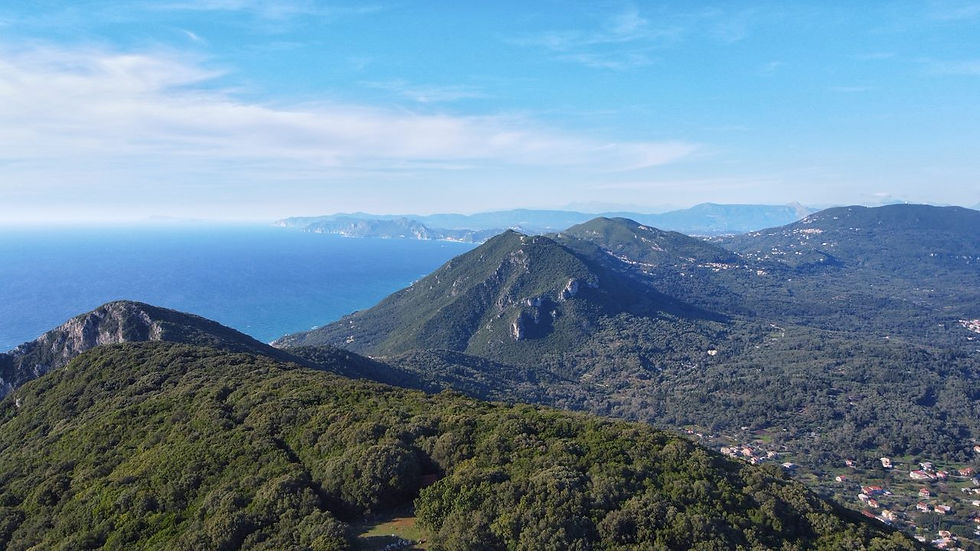Hiking: A Heart-Healthy Guide for People with Cardiac Conditions
- Jamie Pickett

- Aug 24
- 6 min read
“Of all the paths you take in life, make sure a few of them are dirt.” — John Muir

Quick take
Hiking is essentially brisk walking on varied terrain. With sensible planning, most people in cardiac rehab can enjoy it safely. Aim for light-to-moderate effort (Borg RPE 9–13), build up gradually, and use longer warm-ups and cool-downs.
What counts as hiking?
Any purposeful walk on trails, parks, hills, or coastal paths with uneven ground, steps, mud, or gradients. It can be short, local, and low-level, or longer hill days and multi-day treks. If you’re new or returning after a cardiac event, start with easy, well-waymarked routes and modest elevation gain.
Benefits for heart and mind
Improves aerobic fitness, blood pressure, cholesterol profile, and insulin sensitivity.
Builds leg strength, balance, and bone health (especially with gentle hills and poles).
Supports weight management and mood, reduces stress, and promotes better sleep.
Social, scenic, and motivating — green spaces add an extra wellbeing lift.
Is hiking suitable for me? (readiness checklist)
You’ve been cleared by your cardiac team to exercise and can walk 30–40 minutes on flat ground at RPE 11–13 without symptoms.
Your medication is stable and you know how it affects heart rate and effort.
You can manage small hills on local walks without undue breathlessness (RPE ≤ 13).
You have a plan for hydration, weather changes, and getting help if needed.
Safety first: delay or stop if…
You have chest pain, tightness, significant breathlessness, palpitations, dizziness, or faintness — stop, sit, and follow your clinical plan. If symptoms persist ≥ 5 minutes, call emergency services.
You’re unwell, febrile, or your resting heart rate is unusually high or low for you.
You’ve missed key cardiac medications or feel “off” — postpone the hike.
Conditions are extreme (very hot, very cold, high winds, ice, lightning) or trail warnings advise against hiking.
“Go as far as you can see; when you get there, you’ll be able to see further.” — Thomas Carlyle
How hard should it feel? (Borg 6–20 + heart rate)
Warm-up: RPE 8–10 for 8–10 minutes.
Main hike on easy terrain: RPE 11–13 (comfortable conversation).
Short hills/steps: brief rises to RPE 13–14, then settle back.
Cool-down: RPE 7–9 for 8–10 minutes.
If you use heart rate, typical target is 40–70% of heart-rate reserve (HRR). On beta-blockers or if HR feels unreliable, prioritise Borg RPE and the talk test.

Warm-up and cool-down
Warm-up (8–10 minutes): start on the flat, gradually increasing pace; include gentle ankle circles, calf raises, knee lifts, hip openers, and shoulder rolls.
Cool-down (8–10 minutes): ease to a very easy walk, then hold light calf, hamstring, quad, and hip-flexor stretches for 20–30 seconds each, plus relaxed breathing.
Technique and pacing basics
Shorten your stride and increase cadence slightly on hills to keep RPE ≤ 13–14.
Use trekking poles for stability, joint unloading, and rhythm.
On descents: soften knees, keep hips under you, and place feet flat to reduce impact.
Take micro-breaks (30–60 seconds) to keep effort steady rather than long slogs.
Equipment, footwear, and simple packing list
Supportive hiking shoes or boots with grippy soles; wear in gradually.
Layered clothing, waterproof shell, hat, light gloves; spare warm layer.
Small pack, water (0.5–1 L per hour depending on heat), light snacks.
Charged phone, trail map/app, ID/medical info, any rescue or location app used locally.
Simple first-aid items, blister care, any personal meds (carry GTN if prescribed).
Weather, environment, and altitude
Heat: start early, shade where possible, hydrate little and often, slow the pace.
Cold/wet/windy: insulate, waterproof, keep moving gently, avoid exposed ridges.
Altitude: if hiking above ~1,500–2,000 m and you’re new to it, progress gradually; keep RPE lower than usual, avoid rapid ascents, and seek clinical advice for higher treks.

Medication and condition-specific notes
Beta-blockers: expect lower HR at a given effort; go by RPE and breathing.
Nitrates/GTN: carry as directed; if you need it, stop and follow your plan.
Anticoagulants: prioritise stable footing, poles, and gentler descents to reduce fall risk.
Diabetes: bring snacks and testing kit; check glucose before, possibly during, and after longer hikes; watch for hypos on longer/colder days.
Pacemaker/ICD: carry your device card; hike with a partner or group; choose routes with mobile coverage where possible.
Trail nutrition and hydration
Drink regularly from the start; clear or pale-straw urine is a simple guide.
Bring easy carbs for > 60–90 minute hikes (fruit, oat bars, sandwiches).
Add electrolytes on warmer days or longer efforts.
“Success is the sum of small efforts, repeated day in and day out.” — Robert Collier
A simple session template (30–60 minutes)
Warm-up: 8–10 minutes easy walking on flat ground.
Main section: 15–35 minutes at RPE 11–13. Include 3–6 short hills or stair bouts of 1–3 minutes at RPE 13–14, separated by easy walking.
Cool-down: 8–10 minutes very easy walking and stretches.
Progressive 12-week hiking plan (choose your level)
General notes: 2–3 hikes per week on non-consecutive days. Keep most work at RPE 11–13, with short hills to RPE 13–14. If a week feels too hard, repeat it before progressing.
Beginner (from regular flat walks):
Weeks 1–2: 30–35 min per hike, ≤ 50 m total ascent, 1–2 short hills.
Weeks 3–4: 35–40 min, ≤ 75 m ascent, 2–3 hills or steps.
Weeks 5–6: 40–45 min, ≤ 100 m ascent, add one slightly longer hill (2–3 min).
Weeks 7–8: 45–50 min, ≤ 150 m ascent, introduce poles if helpful.
Weeks 9–10: 50–55 min, ≤ 200 m ascent, include one gentle, longer trail.
Weeks 11–12: 55–60 min, ≤ 250 m ascent, practice pacing on undulating routes.
Intermediate (already doing 45–60 min walks):
Weeks 1–2: 60 min, ≤ 200 m ascent, 3–4 hill repeats of 2–3 min.
Weeks 3–4: 60–70 min, ≤ 250–300 m ascent, add one steady 10-min climb at RPE 12–13.
Weeks 5–6: 70–80 min, ≤ 350 m ascent, add short technical sections carefully.
Weeks 7–8: 75–90 min, ≤ 400 m ascent, include a back-to-back easy day (30–40 min).
Weeks 9–10: 90 min, ≤ 500 m ascent, practice downhill control.
Weeks 11–12: 90–105 min, ≤ 600 m ascent, choose one scenic “goal” route.
Advanced (comfortable hill walkers building robustness):
Weeks 1–2: 90 min with 500–600 m ascent, controlled descents, poles optional.
Weeks 3–4: 2 hours, 600–700 m ascent, add one sustained 15-minute climb at RPE 12–13.
Weeks 5–6: 2–2.5 hours, 700–800 m ascent, include rough ground sections at easy pace.
Weeks 7–8: 2.5 hours, 800–900 m ascent, practice nutrition/hydration strategy.
Weeks 9–10: 3 hours, 900–1,000 m ascent, focus on steady pacing all day.
Weeks 11–12: 3–4 hours, 1,000–1,200 m ascent, target summit or ridge day in fair weather.
Pre-hike checklist
Route planned and suited to your current level (distance, ascent, terrain, escape points).
Weather checked, clothing layered, footwear broken-in.
Phone fully charged, map/app downloaded for offline use, someone knows your plan.
Water, snacks, meds, ID/medical card, simple first aid, blister care.
Poles if balance or knees benefit, and a small emergency layer.

Travel and insurance (for hikes away from home)
If travelling, ensure your travel insurance covers hiking and declares pre-existing conditions. Some policies limit altitude, distance from roads, or “guided vs unguided” hiking — choose appropriately.
Know local emergency numbers and how to share your location. In remote areas, consider a group hike or qualified guide.
SMART challenges
This week (short-term): choose an easy, local circular trail (≤ 3 km, ≤ 75 m ascent). Hike at RPE 11–13, keep a steady rhythm, and write three positives you noticed about your pacing or breathing.
Next 8–12 weeks (long-term): select a scenic “goal” route that is realistic for your level (e.g., 8–12 km coastal or hill walk). Plan your progression using the 12-week outline above, book a date, and invite a friend or group for accountability.
How can My Movement Medicine Help?
Our Online & Face-to-Face classes aren’t hiking-specific, but they’re excellent cross-training for the trail: you’ll build cardiovascular endurance (Borg RPE 9–13), leg and core strength, balance and stability, and confidence—skills that carry over to uneven terrain, hills, and longer days out. Regular training with us can help lower blood pressure, improve cholesterol and insulin sensitivity, support weight management, and lift mood and sleep.
If you’d like extra guidance, our premium personalised programme turns your health status and goals into a tailored 12-week plan with weekly check-ins—so you progress steadily and safely toward the adventures you have in mind.
Book a free trial class or enquire at www.mymovementmedicine.co.uk.
FAQs
What if my heart rate jumps on hills?
Shorten your stride, slow a little, and use poles; keep effort at RPE 13–14 max on steeper sections, then return to RPE 11–13.
Can I hike alone?
Preferably start with a partner or group. If solo, choose well-used routes with reception, leave your plan with someone, and carry essentials.
What about knee or back discomfort?
Poles, softer trails, and controlled descents help. Keep hips under you on downhills. If pain persists, seek individual guidance.
This blog post was written by Jamie Pickett, Clinical Exercise Physiologist, with AI assistance.





Comments